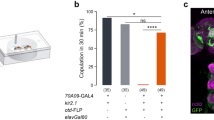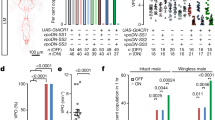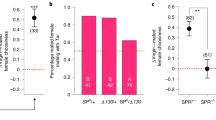Abstract
Learning through trial-and-error interactions allows animals to adapt innate behavioural ‘rules of thumb’ to the local environment, improving their prospects for survival and reproduction. Naive Drosophila melanogaster males, for example, court both virgin and mated females, but learn through experience to selectively suppress futile courtship towards females that have already mated1. Here we show that courtship learning reflects an enhanced response to the male pheromone cis-vaccenyl acetate (cVA), which is deposited on females during mating and thus distinguishes mated females from virgins. Dissociation experiments suggest a simple learning rule in which unsuccessful courtship enhances sensitivity to cVA. The learning experience can be mimicked by artificial activation of dopaminergic neurons, and we identify a specific class of dopaminergic neuron that is critical for courtship learning. These neurons provide input to the mushroom body (MB) γ lobe, and the DopR1 dopamine receptor is required in MBγ neurons for both natural and artificial courtship learning. Our work thus reveals critical behavioural, cellular and molecular components of the learning rule by which Drosophila adjusts its innate mating strategy according to experience.
This is a preview of subscription content, access via your institution
Access options
Subscribe to this journal
Receive 51 print issues and online access
$199.00 per year
only $3.90 per issue
Buy this article
- Purchase on Springer Link
- Instant access to full article PDF
Prices may be subject to local taxes which are calculated during checkout




Similar content being viewed by others
References
Siegel, R. W. & Hall, J. C. Conditioned responses in courtship behavior of normal and mutant Drosophila. Proc. Natl Acad. Sci. USA 76, 3430–3434 (1979)
Tompkins, L. Genetic analysis of sex appeal in Drosophila. Behav. Genet. 14, 411–440 (1984)
Jallon, J. M., Antony, C. & Benamar, O. Un anti-aphrodisiaque produit part les males de Drosophila et transféré aux femelles lors de la copulation. C. R. Acad. Sci. Paris 292, 1147–1149 (1981)
Butterworth, F. M. Lipids of Drosophila: a newly detected lipid in the male. Science 163, 1356–1357 (1969)
Everaerts, C., Farine, J. P., Cobb, M. & Ferveur, J. F. Drosophila cuticular hydrocarbons revisited: mating status alters cuticular profiles. PLoS ONE 5, e9607 (2010)
Kurtovic, A., Widmer, A. & Dickson, B. J. A single class of olfactory neurons mediates behavioural responses to a Drosophila sex pheromone. Nature 446, 542–546 (2007)
Ha, T. S. & Smith, D. P. A pheromone receptor mediates 11-cis-vaccenyl acetate-induced responses in Drosophila. J. Neurosci. 26, 8727–8733 (2006)
van der Goes van Naters, W. & Carlson, J. R. Receptors and neurons for fly odors in Drosophila. Curr. Biol. 17, 606–612 (2007)
Root, C. M., Semmelhack, J. L., Wong, A. M., Flores, J. & Wang, J. W. Propagation of olfactory information in Drosophila. Proc. Natl Acad. Sci. USA 104, 11826–11831 (2007)
Bray, S. & Amrein, H. A putative Drosophila pheromone receptor expressed in male-specific taste neurons is required for efficient courtship. Neuron 39, 1019–1029 (2003)
Chen, P. S. et al. A male accessory gland peptide that regulates reproductive behavior of female D. melanogaster. Cell 54, 291–298 (1988)
Nakayama, S., Kaiser, K. & Aigaki, T. Ectopic expression of sex-peptide in a variety of tissues in Drosophila females using the P[GAL4] enhancer-trap system. Mol. Gen. Genet. 254, 449–455 (1997)
Liu, H. & Kubli, E. Sex-peptide is the molecular basis of the sperm effect in Drosophila melanogaster. Proc. Natl Acad. Sci. USA 100, 9929–9933 (2003)
Wise, R. A. Dopamine, learning and motivation. Nature Rev. Neurosci. 5, 483–494 (2004)
Waddell, S. Dopamine reveals neural circuit mechanisms of fly memory. Trends Neurosci. 33, 457–464 (2010)
Neckameyer, W. S. Dopamine and mushroom bodies in Drosophila: experience-dependent and -independent aspects of sexual behavior. Learn. Mem. 5, 157–165 (1998)
Hamada, F. N. et al. An internal thermal sensor controlling temperature preference in Drosophila. Nature 454, 217–220 (2008)
Friggi-Grelin, F. et al. Targeted gene expression in Drosophila dopaminergic cells using regulatory sequences from tyrosine hydroxylase. J. Neurobiol. 54, 618–627 (2003)
Claridge-Chang, A. et al. Writing memories with light-addressable reinforcement circuitry. Cell 139, 405–415 (2009)
Aso, Y. et al. Specific dopaminergic neurons for the formation of labile aversive memory. Curr. Biol. 20, 1445–1451 (2010)
Dickson, B. J. Wired for sex: the neurobiology of Drosophila mating decisions. Science 322, 904–909 (2008)
Keleman, K., Kruttner, S., Alenius, M. & Dickson, B. J. Function of the Drosophila CPEB protein Orb2 in long-term courtship memory. Nature Neurosci. 10, 1587–1593 (2007)
Kitamoto, T. Conditional modification of behavior in Drosophila by targeted expression of a temperature-sensitive shibire allele in defined neurons. J. Neurobiol. 47, 81–92 (2001)
Stockinger, P., Kvitsiani, D., Rotkopf, S., Tirian, L. & Dickson, B. J. Neural circuitry that governs Drosophila male courtship behavior. Cell 121, 795–807 (2005)
Yu, J. Y., Kanai, M. I., Demir, E., Jefferis, G. S. & Dickson, B. J. Cellular organization of the neural circuit that drives Drosophila courtship behavior. Curr. Biol. 20, 1602–1614 (2010)
Zars, T., Fischer, M., Schulz, R. & Heisenberg, M. Localization of a short-term memory in Drosophila. Science 288, 672–675 (2000)
Isabel, G., Pascual, A. & Preat, T. Exclusive consolidated memory phases in Drosophila. Science 304, 1024–1027 (2004)
Rong, Y. S. & Golic, K. G. Gene targeting by homologous recombination in Drosophila. Science 288, 2013–2018 (2000)
Saudan, P. et al. Ductus ejaculatorius peptide 99B (DUP99B), a novel Drosophila melanogaster sex-peptide pheromone. Eur. J. Biochem. 269, 989–997 (2002)
Hadjieconomou, D. et al. Flybow: genetic multicolor cell labeling for neural circuit analysis in Drosophila melanogaster. Nature Methods 8, 260–266 (2011)
Krashes, M. J., Keene, A. C., Leung, B., Armstrong, J. D. & Waddell, S. Sequential use of mushroom body neuron subsets during Drosophila odor memory processing. Neuron 53, 103–115 (2007)
Dietzl, G. et al. A genome-wide transgenic RNAi library for conditional gene inactivation in Drosophila. Nature 448, 151–156 (2007)
Luo, L., Liao, Y. J., Jan, L. Y. & Jan, Y. N. Distinct morphogenetic functions of similar small GTPases: Drosophila Drac1 is involved in axonal outgrowth and myoblast fusion. Genes Dev. 8, 1787–1802 (1994)
Kamyshev, N. G., Iliadi, K. G. & Bragina, J. V. Drosophila conditioned courtship: two ways of testing memory. Learn. Mem. 6, 1–20 (1999)
Benjamini, Y. & Hochberg, Y. Controlling the false discovery rate: a practical and powerful approach to multiple testing. J. R. Stat. Soc. B 57, 289–300 (1995)
Acknowledgements
We thank E. Leitner for performing the gas chromatography–mass spectrometry analysis; P. Garrity, U. Heberlein, M. Heisenberg, E. Kubli, S. Waddell, the Drosophila Genetic Resource Centre, the Bloomington Stock Center and the VDRC for fly stocks; K. Jandrasits and Z. Portik-Dobos for technical assistance; M. Zimmer for critical comments on the manuscript. Basic research at the Institute of Molecular Pathology is funded in part by Boehringer Ingelheim GmbH. This work was additionally supported by grants from the European Research Council (B.J.D.) and the Austrian Science Fund (K.K.). E.V. was supported by a European Molecular Biology Organization long-term postdoctoral fellowship.
Author information
Authors and Affiliations
Contributions
K.K. and B.J.D. designed the experiments and performed the data analysis. K.K. performed most behavioural experiments. B.J.D. wrote the manuscript together with K.K. E.V. generated the DopR1 and DopR2 mutants, and A.K. generated the Or47b and Gr68a mutants. S.K. and J.Y.Y. performed the antibody stainings.
Corresponding authors
Ethics declarations
Competing interests
The authors declare no competing financial interests.
Supplementary information
Supplementary Information
This file contains Supplementary Figures 1-3 and Supplementary Tables 1-17. (PDF 710 kb)
Rights and permissions
About this article
Cite this article
Keleman, K., Vrontou, E., Krüttner, S. et al. Dopamine neurons modulate pheromone responses in Drosophila courtship learning. Nature 489, 145–149 (2012). https://doi.org/10.1038/nature11345
Received:
Accepted:
Published:
Issue Date:
DOI: https://doi.org/10.1038/nature11345
This article is cited by
-
Ankyrin2 is essential for neuronal morphogenesis and long-term courtship memory in Drosophila
Molecular Brain (2023)
-
Optimized design and in vivo application of optogenetically functionalized Drosophila dopamine receptors
Nature Communications (2023)
-
A neural circuit linking learning and sleep in Drosophila long-term memory
Nature Communications (2022)
-
Predictive olfactory learning in Drosophila
Scientific Reports (2021)
-
Compartment specific regulation of sleep by mushroom body requires GABA and dopaminergic signaling
Scientific Reports (2021)
Comments
By submitting a comment you agree to abide by our Terms and Community Guidelines. If you find something abusive or that does not comply with our terms or guidelines please flag it as inappropriate.



